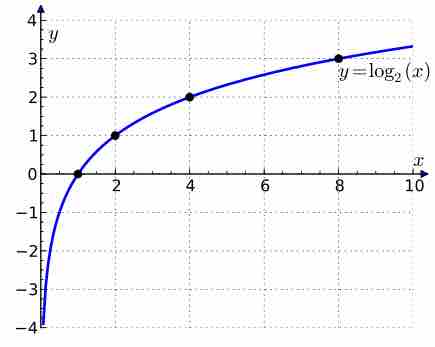The logarithm of a number is the exponent by which another fixed value, the base, must be raised to produce that number. For example, the logarithm of 1000 to base 10 is 3, because 1000 is 10 to the power 3: 1000 = 10 10 10 = 103.
More generally, if
The logarithm to base
The idea of logarithms is to reverse the operation of exponentiation, that is raising a number to a power. For example, the third power (or cube) of 2 is 8, because 8 is the product of three factors of 2:

Plot of $\log_2(x)$
The graph of the logarithm to base 2 crosses the x-axis (horizontal axis) at 1 and passes through the points with coordinates (2, 1), (4, 2), and (8, 3). For example, log2(8) = 3, because 23 = 8. The graph gets arbitrarily close to the y axis, but does not meet or intersect it.
A naive way of defining the logarithm of a number x with respect to base b is the exponent by which b must be raised to yield x. In other words, the logarithm of x to base b is the solution y to the equation:
This definition assumes that we know exactly what we mean by 'raising a real positive number to a real power'. Raising to integer powers is easy. It is clear that two raised to the third is eight, because 2 multiplied by itself 3 times is 8, so the logarithm of eight with respect to base two will be 3.
However, the definition also assumes that we know how to raise numbers to non-integer powers. What would be the logarithm of ten? The definition tells us that the binary logarithm of ten is 3.3219 because two raised to the 3.3219th power is ten. So, the definition only makes sense if we know how to multiply 2 by itself 3.3219 times.
For the definition to work, it must be understood that ' raising two to the 0.3219 power' means 'raising the 10000th root of 2 to the 3219th power'. The tenthousandth root of 2 is 1.0000693171 and this number raised to the 3219th power is 1.2500, therefore ' 2 multiplied by itself 3.3219 times' will be 2 x 2 x 2 x 1.2500 namely 10.
Making this proviso, if the base b is any positive number except 1, and the number x is greater than zero, there is always a real number y that solves the equation:
The logarithm is denoted "logb(x)". In the equation y = logb(x), the value y is the answer to the question "To what power must b be raised, in order to yield x?". To define the logarithm, the base b must be a positive real number not equal to 1 and x must be a positive number.